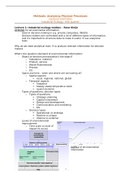Samenvatting
Summary ALL Lectures and Notes: Methods: Analysing Physical Processes, MSc Industrial Ecology
A summary of ALL the lectures and notes for the MSc course Methods: Analysing Physical Processes in the Industrial Ecology course (TUDelft/Universiteit Leiden). Contains information treated in the lectures, also of several guest lecturers. Contains: - Lecture 1: Industrial Ecology toolbox (Ren...
[Meer zien]




